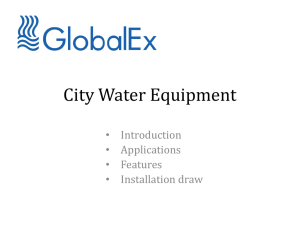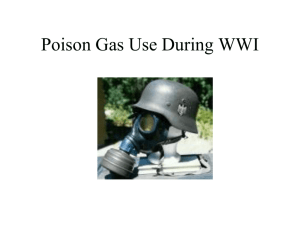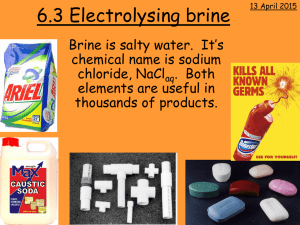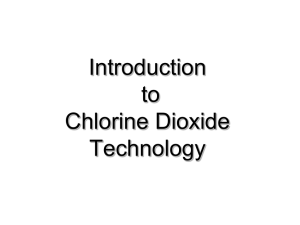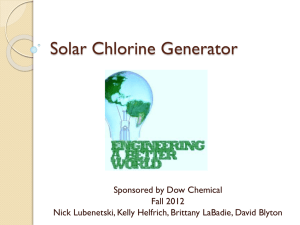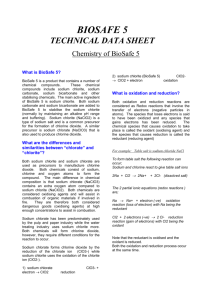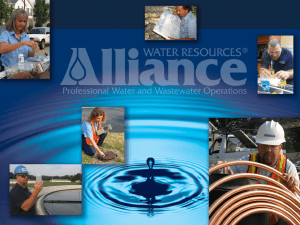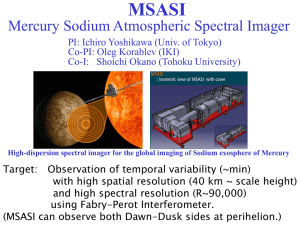chlorine dioxide - Proform Industries
advertisement
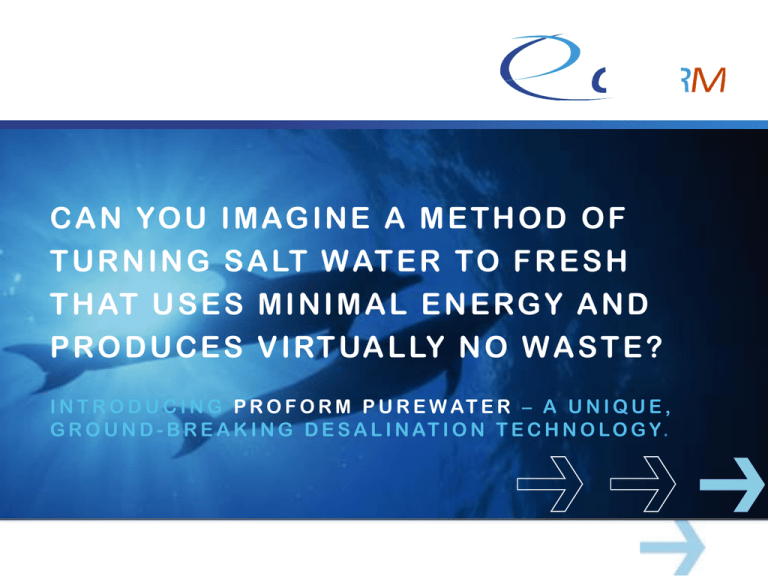
C A N YO U I M AG I N E A M E T H O D O F T U R N I N G S A LT W AT E R TO F R E S H T H AT U S E S M I N I M A L E N E RG Y A N D P R O D U C E S V I RT UA L LY N O W A S T E ? I N T R O D U C I N G P R O F O R M P U R E W AT E R – A U N I Q U E , G R O U N D - B R E A K I N G D E S A L I N AT I O N T E C H N O L O G Y. P R O F O R M P U R E W AT E R : A N OV E RV I E W Proform has secured an interest in Proform PureWater, a new desalination technology, entering into a partnership and exclusive license agreement with the patent owner. Proform PureWater promises to deliver unlimited volumes of clean water, while providing fuel to generate large amounts of electricity. Our goal is to further develop, manufacture and commercialize this ground-breaking technology. We are in our first phase of development, building a prototype to evaluate quality and quantities of effluents, energy consumption and production, and the potential for further commercialization, introduction to market and revenues. T E C H N O LO G Y OV E RV I E W The Proform PureWater self-powered desalination unit holds promise for localized water purification with separate revenue streams from naturally occurring by-products and near-zero greenhouse gas emissions. The unique Proform PureWater process combines salt water desalination with the simultaneous production of potable water, hydrogen, sodium hydroxide, and chlorine dioxide or chlorine using a proprietary and sustainable clean energy process. The technology operates in any environment near coastal regions through self-contained, scalable and portable 500 gallon per minute units. P OT E N T I A L C U S T O M E R S Proform PureWater has attracted interest from the City of College Station, Texas as an affordable way to remove high concentrations of salt (sodium chloride) from their aquifer source water supply, enabling them to use these higher brine concentration wells. Additional interest has been expressed by Department of Energy and the US Navy, City of Bryan, City of Nassau Bay, Bay Area Economic Partnership Cities, Valero, US Virgin Island Utility Company, El Paso Water Utilities, Austin Energy and City Public Service/SAWS (San Antonio). M A R K E T O P P O RT U N I T I E S THE COMBINATION OF REVENUE SOURCES RESULTING FROM THE SINGLE PROFORM PUREWATER PROCESS OFFERS A MULTITUDE OF COST-EFFECTIVE MARKET OPPORTUNITIES: WATER • Water shortages, water quality and disinfection problems • Water conservation in cooling towers and evaporation processes • Produced water (a by-product of the oil industry) disposal ENERGY • Renewable and clean energy production • Distributed generation that is scalable and cost efficient • Fleet vehicle fuel potential CHEMICALS • Chlorine dioxide production (cost competitive with chlorine) • Sodium hydroxide production • Hydrogen gas production when necessary CARBON DIOXIDE CONVERSION • Sodium hydroxide mixed with carbon dioxide affordably produces sodium carbonate (glass component), or sodium bicarbonate (buffer, baking soda). M A R K E T O P P O RT U N I T I E S AGRICULTURE • Many foods are produced with sodium hydroxide including corn to hominy, green olives to black olives. • Fuel and water are major cost components of farming and ranching. • New Holland produces hydrogen-powered fuel cell tractors. FLY ASH CEMENT • New technologies are emerging for production of alternative cements that utilize 100% fly ash. • Fly ash is the by-product of coal-fired electrical plants and most is dumped in landfills. • Fly ash sells for about $20 per ton which can produce over 1 cubic yard of concrete. • Sodium hydroxide is the major cost item. • Concrete production contributes nearly 10% of the world’s greenhouse gases. • Concrete is the single largest volume item produced by man. • China is completing one coal-fired electrical plant every month. REVENUE STREAMS HYDROGEN GAS/ELECTRICITY To avoid transportation/liability issues and to increase profitability, pure hydrogen can be combusted in conventional boiler/steam turbine electrical generators with modified burner technology. In addition, Organic Rankine Cycle Generators (United Technologies, Ormat) can be used in smaller applications. Finally, an internal combustion piston engine technology has been developed for pure hydrogen combustion electricity generation. Industrial electric rates range from $0.08 to $0.50 per kWh in Hawaii and the US Virgin Islands. Hydrogen gas can be sold for numerous other applications including sulfur removal from oil. SODIUM HYDROXIDE (NaOH) Also known as lye or caustic soda, sodium hydroxide is the 2nd most prolific industrial chemical in the world. In 2004 worldwide demand was 51 million dry metric tonnes. The major U.S. producer is Dow Chemical. 56% of NaOH supply is used by the chemical industry, 25% by the paper industry, and most of the remainder is used by the petroleum refining industry and aluminum refining. It is also used to make soap. Distributor pricing varies from $200 to $400 per 55 gallon barrel at 50% weight to weight (i.e. equal weights of water and sodium hydroxide per barrel), depending on purity – membrane grade to reagent grade. Proform PureWater generally produces reagent grade. REVENUE STREAMS CHLORINE DIOXIDE/CHLORINE Both chemicals are used in water disinfection and PVC manufacture. Chlorine dioxide is explosive and therefore only produced on-site. Although preferred over chlorine, chlorine dioxide is considerably more expensive than chlorine (5-10 times) and therefore not as common. Chlorine dioxide generally costs from $.82 to $2.15 per pound to municipalities. Chlorine dioxide has 3 major benefits over chlorine: a wider spectrum of microbial disinfection it’s a longer lasting chemical even at lower concentrations no carcinogen (trihalomethane) formation like chlorine with organics WATER Proform PureWater provides a three-step treatment methodology that is simpler and less expensive than comparable techniques. In the U.S., municipal water at industrial rates costs generally between $2.00 - $5.00 per thousand gallons. STEP 1 - Cation precipitation and organics oxidation with Proform PureWater anode oxidants STEP 2 – Sodium chloride removal/desalination STEP 3 – Disinfection with chlorine dioxide REVENUE STREAMS HYDROGEN GAS/ELECTRICITY $16 Million/Year SODIUM HYDROXIDE (NaOH) $2.8 Million/Year CHLORINE DIOXIDE/CHLORINE $16 - $130 Million POTABLE WATER $0.25 Million/Year (Based on Location) P R O F O R M P U R E W AT E R T E C H N O LO G Y I N D E TA I L Proform PureWater’s electrolytic technology involves proprietary electrode coatings and membranes in a configuration that permits a continuous, sustainable reaction with valuable by-products from salt water (NaCl). Configured as a three-chamber cell, the cathode chamber is separated from the salt water chamber by its proprietary cation selective membrane. This permits only sodium ions (Na+) to enter the cathode chamber and react with the negative electrode, producing sodium hydroxide (NaOH) and hydrogen (H2) gas. An anion selective membrane permits only the chlorine ions (Cl-) to pass into the anode chamber and react with the positive electrode. Depending on the electrode coatings and other factors, this produces more hydrogen gas (H2) and customizable mixtures of chlorine dioxide (ClO2), chlorine gas (Cl2), ozone (O3), peroxide (H2O2), and hypochlorous (OCl-) – all very strong oxidants (except H2) and the most effective biocides known to man. The middle chamber contains most of the water, which has now been desalinated. H O W P R O F O R M P U R E W AT E R C OPROFORM’S M PA RPUREWATER E S TECHNOLOGY IS SUPERIOR TO THE TWO OTHER CONVENTIONAL DESALINATION METHODS IN FOUR WAYS: EFFLUENT DISPOSAL Conventional technologies concentrate the salt into a portion of the water that has to be disposed. This often causes ground water contamination issues or negative marine life impact. Proform PureWater technology has no effluent disposal, just valuable byproducts and water. LIMITATIONS Conventional technologies have limitations that prevent their use in higher brine concentrations. Proform PureWater has no concentration limitation; in fact, the higher the concentration of salt, the more by-products – and the higher the profitability. H O W P R O F O R M P U R E W AT E R C O M PA R E S BY-PRODUCTS Conventional technologies are expensive with no by-products other than water and salt. In contrast, Proform PureWater produces sodium hydroxide – the second most often used industrial chemical; hydrogen gas and/or power; chlorine products including chlorine dioxide – the most effective water disinfectant; and finally, clean, potable water. PRETREATMENT Conventional technologies require considerable and expensive pretreatment. Proform PureWater also requires pretreatment, but our technology produces the chemicals required for pretreatment, via the oxidants produced in the anode chamber. Proform PureWater technology provides a complete treatment system, from raw sea water to drinking-quality freshwater. NEXT STEPS Construct a scaled-up unit that quantifies: 1) the by-product production and economics, and 2) optimizes the efficiency of the process for commercial potential. Construct a trailer-mounted desalination unit (minimum 20 gallons per minute) that will take raw brackish or brine water and process it to drinking water standards, and possibly bottled water standards. Quantify the sodium hydroxide (NaOH) concentration production, purity and container economics. Quantify the pure hydrogen production and then the hydrogen combustion to electricity generation economics. Determine equipment requirements for integration of the desalination/hydrogen generation and boiler combustion/steam turbine units. Quantify the nitrous oxide (NOx) emissions and any mitigation strategies involving use of hydrogen peroxide and/or sodium hydroxide; determine economics. Quantify the chlorine dioxide production and determine chemical introduction equipment for water disinfection. Quantify process required and economics for chlorine conversion. Quantify the water quality potential and economics gradient. Quantify the process efficiency, overall economics and location variables. FUNDING REQUIREMENTS PHASE 1 - R & D and Prototype Design & Construction Design and build a scaled prototype at 200 GPM Secure government grants (Canada/USA or EU) Finalize commercialization strategy Initiate marketing strategies and identify markets & strategic partners $3M-$5M PHASE 2 - Marketing, Commercialization & Engineering Determine manufacturing design and engineering Establish extended sales team Establish a manufacturing engineering team Formalize marketing strategy Establish manufacturing strategy Secure additional capital and/or financing $8M-$10M PHASE 3 - Sales, Distribution & Manufacturing Secure additional capital and/or financing Establish manufacturing location, capital equipment and staff Establish installation and maintenance strategy Identify strategic partners for specific projects PPA contracts and agreements Sales contracts $20M-$25M F O R M O R E I N F O R M AT I O N A B O U T P R O F O R M P U R E W AT E R RICHARD COCQ EMIL ROBERT T. 416-788-5542 rcocq@proformindustries.com T. 647-272-3536 erobert@proformindustries.com DESIGN | LBI ADVERTISING CANADA PROFORM INDUSTRIES LTD 2400 Skyline Drive, Suite #300 Dallas TX 75149
